The Martha Graham Dance Company celebrates Appalachian Spring‘s 70th with a new work by Nacho Duato.
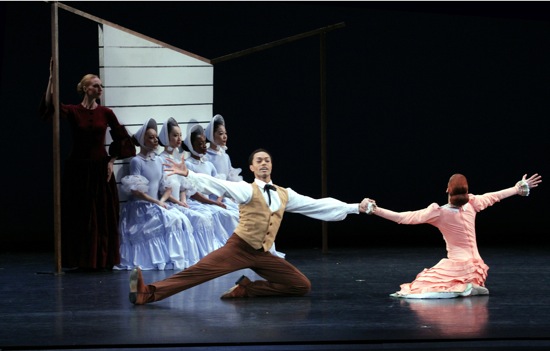
Martha Graham’s Appalachian Spring. Foreground: Abdiel Jacobsen and Blakely White-McGuire. At back (L to R): Katherine Crockett. Charlotte Landreau, Xiaochuan Xie, Tamisha Guy, Ying Xin. Photo: Costas
Martha Graham’s Appalachian Spring was first performed in October of 1944 in the Coolidge Auditorium at the Library of Congress on a not very large stage intended for chamber music concerts. Its back and side walls with working doors would have made it awkward for the eight dancers to make many exits and entrances. Maybe that’s why, once they have walked onto the stage, none of them leaves until the piece is ending.
It seems all the more miraculous then that this incomparably beautiful dance—celebrating its 70th birthday this year—should tell of the open, untamed spaces that governed life in the long, green, sparsely settled valleys of Appalachia at the end of the 19th century. Seeing Appalachian Spring during the Martha Graham Dance Company’s recent City Center season, I’m reminded yet again of certain sentences that Edwin Denby wrote after he saw the piece in 1944: “The separateness of the still figures from one another, which their poses emphasize, suggests that people who live in these hills are accustomed to spending much of their time alone. Their outlines don’t blend like those of townsmen.”
Denby was referring to the fact that when one of the characters performs a solo or two embark on a duet, the others remain motionless in specific places onstage. The Pioneering Woman may sit in her rocking chair, the Bride on the porch steps of her new home; the Husbandman surveys his land across a split-rail fence; the Preacher stands on a little slanted wooden platform that no one else uses; and his four female Followers sit demurely along a bench. Removed from the action, they wait, frozen in time, staring into space, when one of them expresses feelings—apprehensive or optimistic or tormenting—best kept private. After which outbursts, the wedding celebration that has brought them together resumes.
The dancers often seem to stare into the distance, and both the setting and the music emphasize great space. Isamu Noguchi’s small house wall and slender beams make survival in the wilderness seem a fragile endeavor. Aaron Copland’s magnificent music abounds in open intervals; you can almost hear the wind blow through it. To convey on a little concert stage human beings’ sense of their own smallness and isolation in a surrounding wilderness, you have to be a genius.
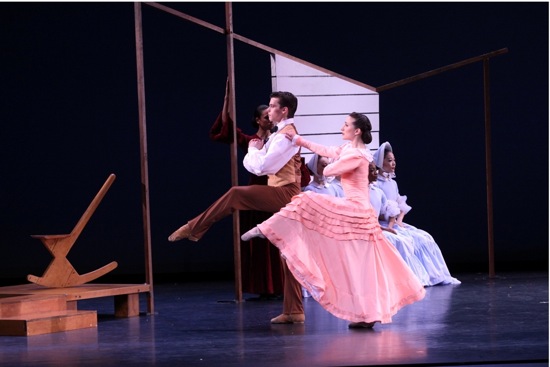
Another cast in Graham’s Appalachian Spring: Lloyd Mayor and Mariya Dashkina Maddux as the Husbandman and the Bride. Photo: Costas
At City Center, Appalachian Spring opened a program that announced a theme: the spring that should be coming any day now. The other two works shown took a darker view of seasonal renewal: Nacho Duato’s new Depak Ine, created for the Graham company, and Graham’s 1984 Rite of Spring.
I know Appalachian Spring too well and love it too much not to want to believe every moment of it. I wince when small, telling details or meaningful movements appear to have eroded. For instance, Graham, as seen in Nathan Kroll’s 1958 film, skips fleetingly (perhaps in memory of the girlhood that she is leaving, perhaps in joy), while all the others, their backs to us, kneel in prayer, hands folded. She turns and moves toward them as if to join in, but once close to them she stops and quietly and decisively (with a great actor’s perfect timing) clasps her hands behind her. No, she, Martha, will not be praying like that. I miss that clear statement in Blakely White-McGuire’s performance. She is, however, a warm and lively Bride—believable in her joy and her playfulness, but aware of the responsibilities that she must assume. She swishes her pink taffeta skirt as if she were sweeping away any too-dark thoughts that might cloud this day.
Lloyd Knight, a dancer I admire, plays the itinerant Preacher with a good sense of both the character’s righteousness and his torment over the sins that he shares with his small flock. But sometimes he pushes these so hard that they blur or distort the movement. The brief passage when the dignified Preacher scuttles crabwise forward on his hands and feet, chest to the sky has become a clumsy token of itself. His bow to his girl followers is so deep that it loses the additional significance of “you will please sit now” and the carefully time wit of the leader’s last nod to the follower who hesitates.
Abdiel Jacobsen imbues the Husbandman with warmth and strength, especially when dancing with his wife-to-be, although he often adopts a puffed-up stance, with his gaze slightly above the horizon line. I think that he, an excellent dancer, means to convey strength and masculinity, but that choice works against his character as a good, simple, happy man with a woman to marry and land to till.
Katherine Crockett’s Pioneering Woman is gentle, open, and refreshingly without affectation. This time, I found her a little under energy, which is surprising. When she has a turn meeting each of the four followers in a circle, they don’t show us the lusty elbow swings that match the big swing of Copland’s music at that point, but barely take hold, as if they’re all too delicate for such carrying on. Knight and the women, in a similar festive circle, make their folk-dancey hand-claps in passing look more like high-fives. Graham’s choreography for those four women is a marvel of wit. Tamisha Guy, Charlotte Landreau, Xiochuan Xie, and Ying Xin show us with conviction their angelic solidarity, their bounding energy, and their slightly sacrilegious devotion to their Preacher.
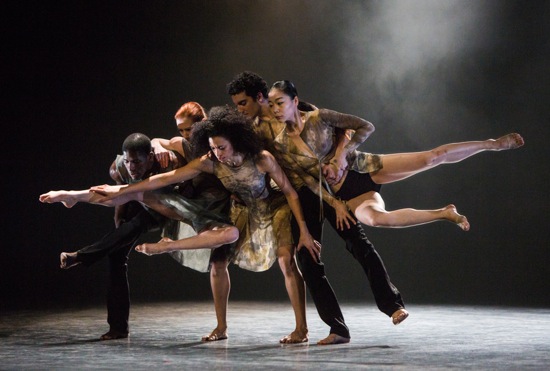
(L to R): Lloyd Knight, Blakely White-McGuire, Natasha Diamond-Walker, Lorenzo Pagano, Ying Xin in Nacho Duato’s Depak Ine. Photo: Yi-Chun Wu.
For members of the MGDC, keeping Graham’s masterworks fresh is an ongoing challenge, but they rise with gusto to new dance that dare them in other ways. When the cast of Depak Ine managed to get Nacho Duato onstage for a bow after the curtain came down on the work he made for them, they applauded him almost as enthusiastically as the audience applauded them.
Depak Ine, choreographed for the Graham company by Nacho Duato, is one of two premieres this season (I was unable to see Andonis Fondianakis’s Echo). Depak Ine is named after a cut on John Talabot’s album Fin. I have no idea what the two words mean (Talabot is a Spanish dj, producer, and composer-musician). The other piece of music that accompanies the dance is Athos-Montana Sacra by Serbian composer Arsenije Jvanovic. The dance too is as mysterious and as haunted as the music. Perhaps to get us thinking along evolutionary lines, the company’s artistic director, Janet Eilber, mentioned in her introductory speech that Duato had been reading the work of Charles Darwin.
As Depak Ine begins in dim light (by Bradley Fields), a woman is lying prone in a downstage corner; slim and pale in a flesh-colored leotard, she could be very young. She looks discarded, dead. A man (Knight) scrabbles rapidly along on his back in her direction. When he stands, Natasha Diamond-Walker rushes, drops to the floor, reaches between his legs, and grabs his crotch. A distant knocking sound is heard and what could be a humming voice. By some extraordinary maneuvering Diamond-Walker and Knight tangle together until they look like a large ball with two cheek-to-cheek faces staring out of it toward the unmoving woman beside them.
When people of this tribe or species appear, they do so out of blackness at the rear of the stage, and they leave as if sucked back there. Lorenzo Pagano appears in that way to hover over the initial pair. Jacobsen materializes commandingly; he’s wearing a loose black robe of some kind that makes him appear priestly (costumes by Angelina Atlagic). White-McGuire and Xin also drift from the dark. As the music swells and deeper voices well up within it, the performers break from a brief cluster and begin to couple and combine in fascinating, repellent, extremely unusual ways. You see elbows and knees as crooks in which elbows and knees and necks belonging to others get caught. Often someone’s neck is trapped by someone else’s flexed ankle. Pagano, reptilian, humps his way across the stage on his belly. When he thrashes, Jacobsen grabs his head (to calm him?), and White-McGuire wraps herself around one of his legs. Xin pulls a hank of her long black hair across her face. People get dragged, lifted. The dancers appear both angular and boneless (how is this possible?). Legs are spread, crotches displayed.
What have we been expecting to come of this? Me, not exactly what ensues. After some of the creatures peer one last time at the prone figure and disappear, she begins to twitch and kick and undulate. She wraps her legs around themselves in strange, hobbled ways. Now we can see her face; it is PeiJu Chien-Pott. The music changes; bird song is heard; a martial beat thuds up underneath. Three men stroll in—just serious ordinary-looking men; they could be traffic cops arriving on the job. These men (Tadej Brdnik, Lloyd Mayor, and Ben Schultz) lift and twist and drag the woman-creature (all in a day’s work). In one startling image, all three hoist her huddled form by one of her slim arms. She’s awkward then not. She lashes them with her hair and becomes beastly. When the men drop into a pile, she climbs onto them and stares at the sky.. What is happening? After what seems like a very long time of gibbering dementedly with her body (Chien-Pott is terrifying), this creature makes her way back to her spot and lies down in her original position. The birds’ chirping starts up again. Jacobsen, near her, puts a gray cloth over his face and staggers backward into darkness.
Did spring just come? I don’t think so. Darwinian evolution? Not so much. Chien-Pott might have been resurrected to take on all the evil in the community. If so, you want to wish its citizens good luck. Poor saps. That is, poor saps, but extraordinary dancers. With immense skill and ferocious concentration, they hurl themselves into the punishing, eye-catching contortions and relationships that Duato has devised. I’m guessing Martha would have been amazed, appalled, and very proud of them.
The program ended with Graham’s Rite of Spring, set to the magisterial and controversial 1913 score by Igor Stravinsky. Graham was 90 when she choreographed it. The cast I saw at City Center was the same one I wrote about when the company performed at Jacob’s Pillow last summer: (https://www.artsjournal.com/dancebeat/2013/08/another-rite/). Watching Xie convey terror, exhaustion, resignation, and despair most eloquently, I thought again how interesting it was that Graham did not have the maiden dance herself to death, as Nijinsky’s victim-heroine did in 1913 and Massine’s did in 1921. Graham herself appeared in the role when Massine revived his version in New York in 1930, and those who took part in it remember the many, many jumps she did in a row (“like knives,” Bessie Schönberg said). Graham taking to the air was unusual at that point. But in her Rite, the woman to be sacrificed doesn’t die dancing; she’s just a poor frightened thing. That’s something to ponder.

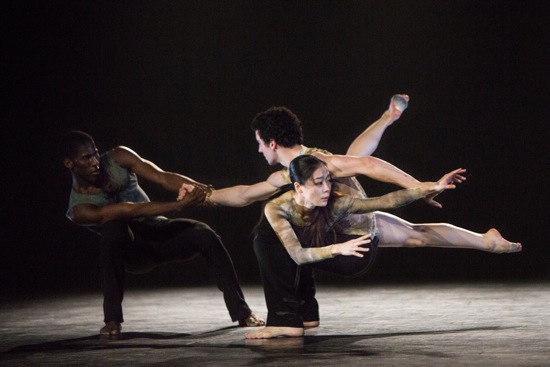
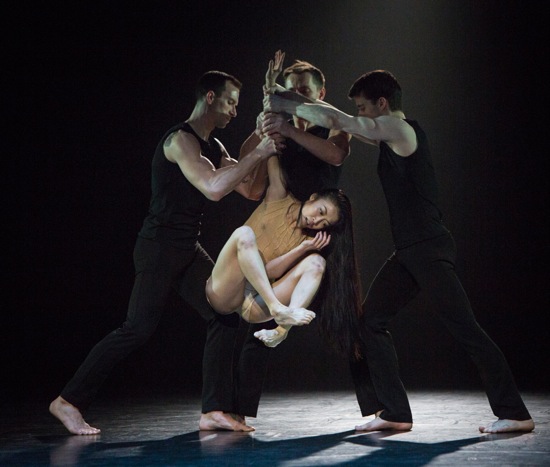
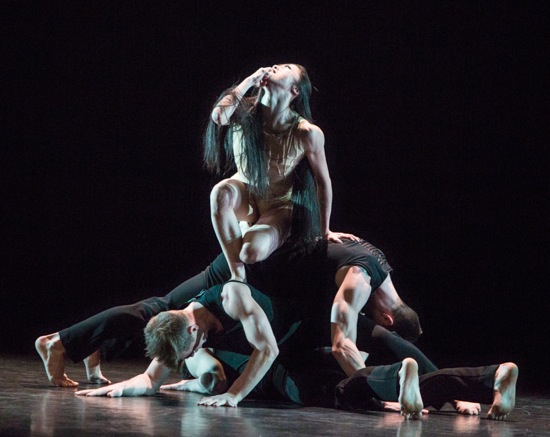
Doesn’t the Preacher stand on a slanted “rock”? When did he begin to stand on a wooden platform?
Also, despite the company’s celebration of “Appalachian Spring”‘s 70th, it couldn’t find even a line in the program to honor Yuriko Kikuchi–one of Graham’s mainstays for over 50 years, the founder of the Martha Graham Ensemble, and reconstructor of many works from the 1930s and early ’40s. Yuriko is the last surviving member of AS’s original cast; it was, in fact, the first work she performed after Graham took her into the company. Is this worse than the fact that someone has also rechoreographed big chunks of Graham’s “Panorama,” presented at the gala, which Yuriko reconstructed in the early 1990s, and for which reconstruction a film of the premiere at Marymount Manhattan Theater, c. 1991-2, survives? And is it possibly even worse than the fact that the rechoreographed parts included the center section, which has been recorded on the 1935 archival, 11-minute film of “Panorama” excerpts with its original Bennington cast and which Yuriko reproduced exactly in her reconstruction of the full, 20-minute score? I worked to get this company a grant, small but real, to help recover the materials damaged in Hurricane Sandy. But I’m astounded by its cavalier attitude toward both Graham’s repertory and one of her major demonstrators, teachers, and reconstructors.
A quick response to Mindy Aloff”s first sentence. I believe that everything in Noguchi’s set for Appalachian Spring has always been made of wood. Anyone applying the term “rock” to the Preacher’s home base must be using it metaphorically.
Thanks, Deborah, though I was speaking of the image rather than the construction materials. That’s why I put the word in quotation marks.
So it’s not supposed to look like a rock? Interesting. Must be the dark paint that gives it a stony look.
For the eloquence of your writing about Appalachian Spring I thank you from the heart Deborah. And I looked up the set in Robert Tracey’s book on Noguchi’s sets for dance and while it may be intended to represent a boulder, the Preacher is standing on a tilted wooden platform that looks a little like a Pilates balance device.